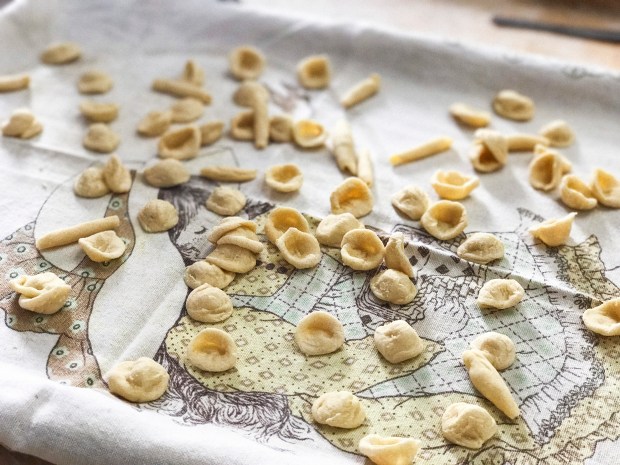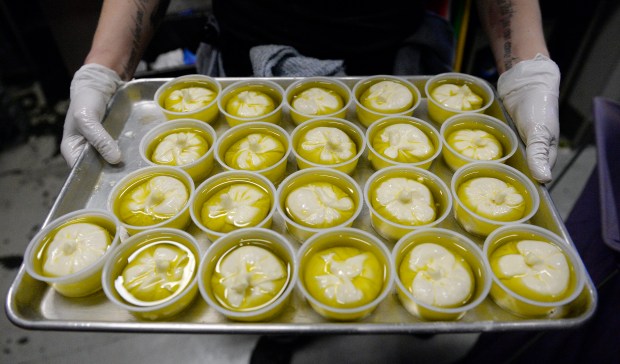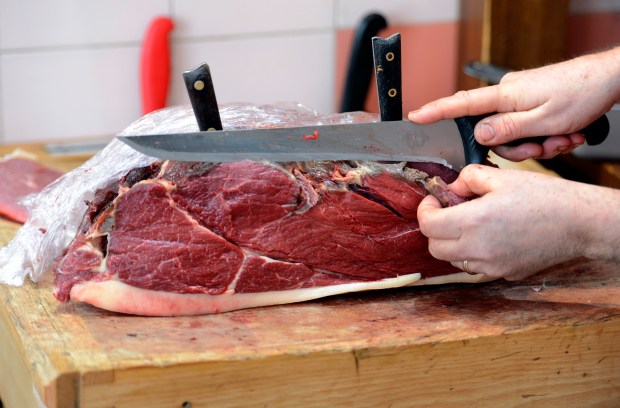Stretches of Puglia’s long coastline, which wrap around Italy’s heel and include the Adriatic Sea along the region’s east coast and the Ionian Sea along the west, still have a prehistoric feel, thanks to their rocky texture. While the major port cities of Taranto and Bari hold commanding positions on the sea—and offer a seafood-based diet as a result—most of Puglia’s historically important towns were founded inland to protect against invading fleets and pirates, resulting in vegetal and meat-based cuisines. These realities mean the region can hold the attention of hungry fish lovers and carnivores equally. The rich and fertile soil of this elongated and geographically varied region means there are plenty of seasonal fruits and vegetable dishes to satisfy vegetarians and even vegans.
Durum Wheat
The western part of the region rises up from the sea to a plateau called the Murgia. This was the breadbasket of ancient Italy, and today the vast plains of the Murgia grow durum wheat for semola di grano duro (semolina), a main ingredient in the area’s hand-shaped pastas and rustic breads. Semolina is one of those words that gets a bit mixed up in translation. It’s not a grain, but rather the term that describes coarsely ground durum wheat. In milling a coarser grind gives a bigger yield, which is likely why semolina is so common in southern Italy, where frugal practices reign. As for the shapes, locals listened to their pasta doughs and developed forms that best adapted durum’s high gluten potential but low extensibility. The result was short, thick pasta shapes, like cavatelli and orecchiette.

Pane di Altamura is a hearty durum wheat loaf that is sliced and eaten fresh, toasted for bruschetta, or allowed to become stale and ground into breadcrumbs, which are fried and sprinkled over pasta dishes. (Puglia, like the rest of Italy, is a carb-positive region.) Focaccia made around central Puglia is also durum based and features a high-hydration, olive oil–rich dough baked in seasoned sheet pans. Many recipes introduce cooked, riced potatoes to the dough, and focaccia is frequently garnished with tomatoes and oregano. The pan is drenched in oil before the dough is stretched into place, so that when it all goes into the oven, the dough practically fries in the pan as it bakes, rendering the bottom crispy and pleasantly oily.
Olive oil
Since antiquity the people of Puglia have harvested olives in the fall, pressed them into a paste, then extracted their oil, using animal-powered mills to separate the fat from the olive pulp and water. Although the pressing process has been mechanized, the basic methods haven’t changed much over the millennia. Most of Puglia’s olives—at least those destined to become extra-virgin olive oil—are still harvested by hand and pressed the same day, as they have been for thousands of years. Naturally, quality hand-harvested olives come at a cost. Prices for extra-virgin olive oil from Puglia are much higher than prices for other European oils, but the difference in quality is undeniable.
Drive through the outskirts of Bari, Brindisi, and Lecce and you’ll witness the twisted trunks of ulivi secolari, centuries-old olive trees. Sadly, many of these trees have been infected by Xylella fastidiosa. The bacterium, which prevents the trees from bearing fruit, has ravaged millions of trees and counting, leading pugliese to rely on oil from the north of the region, which has been marginally less impacted, or from across the Italian peninsula in Calabria.
Cow’s milk cheeses
The area around the city Andria is ground zero for Italy’s burrata production. This fresh cheese features cream-drenched mozzarella curds encased in a thin mozzarella sheath. Mozzarella in its various shapes—balls, knots, and braids—is produced throughout the region, especially in central Puglia, while caciocavallo, an aged stretched-curd cheese, dominates Puglia’s border with Basilicata, where it is made with the milk of heritage Podolico cows.

Seafood
Puglia’s coastline is lapped by two seas—the Adriatic and the Ionian—both of which are chronically overfished, leaving shellfish and crustaceans among the few reasonably sustainable options, mussels among them. Tiedda di cozze e patate is a casserole of mussels and potatoes, while cozze ripiene are mussels stuffed with seasoned breadcrumbs and baked or fried. Cozze pelose (“hairy” mussels) appear on crudi (raw seafood) platters alongside ricci di mare (sea urchin roe) and gamberi rossi di Gallipoli (sweet red shrimp fished in the Ionian Sea).
Horse meat
Italy imports more horse meat than any other country in Europe, and most of it is destined for Salento, the southernmost part of Puglia. Traditionally, horse meat was eaten out of pure necessity. Peasants would slaughter their animals when they could no longer work the land and then simmer their tough meat in tomato sauces to make dishes like pezzetti di cavallo (horse stew). Today, its appeal is strictly nostalgic.

Lamb, goat, and offal
Lambs and goats graze throughout the region, and when they are slaughtered, no part is wasted. The whole-muscle cuts are butchered and stewed, often in terra-cotta vessels called pignate. Meanwhile, the innards are wrapped in bay leaves or parsley and caul fat and roasted, a dish called turcinieddhri, or gnummareddi. The parcel of organs varies but may include heart, lungs, liver, kidneys, or sweetbreads.
Almonds
This dried fruit appears on the breakfast table as latte di mandorla (literally “almond milk” but more accurately described as almond extract) and on the dessert platter as pasta di mandorla (marzipan). It is ground into shape as mandorlaccio (a flourless almond cake).

Digestifs
All over Puglia fennel, bay leaves, mint, sage, and basil are steeped in alcohol to produce a variety of liquor called rosolio, a stiff after-dinner drink meant to aid digestion. Local fruits like mulberries, cherries, and citrus are also used. Meanwhile in Gallipoli, Amaro Margapoti adapts a century-old family recipe of macerated china, cloves, cinnamon, and other spices to create a digestive liquor that harnesses bitter and herbal flavors.